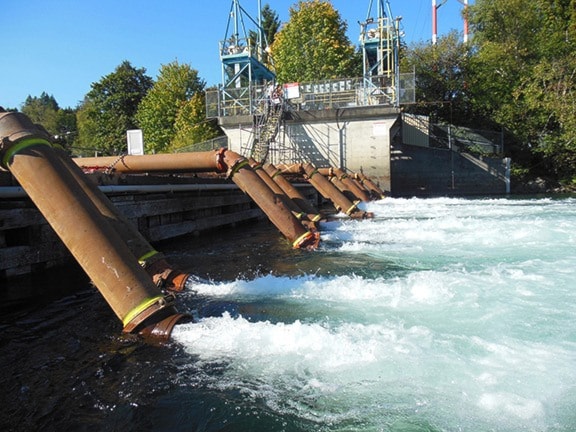Although Cowichan Lake still has enough water north of the weir to sustain the Cowichan River for at least two weeks, representatives from government and industry say the situation is dire and newly installed pumps at the weir are only a bandaid solution.
On Thursday, officials from Catalyst Paper, the CVRD, Lake Cowichan First Nation and Cowichan Tribes commissioned the 20 pumps installed last week, holding a joint press conference on the lakeshore to address questions about their collective response to the increasingly dry weather the region has experienced in recent years.
William Seymour, chief of Cowichan Tribes, said the ability for families to harvest fish from this water system has been an integral part of life for the First Nations people of this area.
"Our families need to be able to go down to the river and catch what they need to put on the table," he said. "When we have to close this river down, we're taking food off their table."
For Catalyst, which relies on the river to operate its pulp and paper mill in Crofton, developing a solution to the water shortages is equally important.
"We've received about a third less water in the summertime into the basin than we did a year ago. Keeping the river flowing is a must," said Graham Kissack, vice-president of corporate social responsibility at Catalyst, noting that the pumps installed at the weir are only a temporary solution. "These pumps represent at half-a-million dollars in cost to Catalyst. Seventy per cent of the water that we'll be pumping is there to protect the fish, the river and other users of the water. The remaining 30 per cent will be used by the mill and the jobs at the Crofton facility."
Staff associated with the project estimate that barring significant rainfall in the coming days, pumping will have to start at the weir on Oct. 12. Kissack said the public will receive notice seven days in advance of any pumping if it is deemed necessary. Catalyst has a licence to pump water from the lake for a maximum of 49 days if necessary.
John Lefebure, mayor of North Cowichan and chairman of the CVRD board of directors, also addressed attendees at the event, highlighting the particularly dire straights the river found itself in this year.
"The flow in the river was reduced to 4.5 cubic metres per second by the end of May. In previous years we have set a desired minimum… that we collectively believed could support the fish of 7 cms. So incredibly early in the year we were faced with a very minimal flow. Not something that supports side channels, the north channel," he said.
Lefebure acknowledged the efforts of individual citizens as well as community organizations like the Cowichan Lake and River Stewardship Society and Cowichan Valley Naturalists' Society, in aiding fish and fry throughout the water system that have been threatened by the low water levels.
He echoed Kissack's remark that the pumps are only a bandaid fix, and said increasing water storage in the lake is a necessary long-term solution. He emphasized the need for all stakeholders to work together in making that happen.
"We are looking to the provincial and federal governments who have had representatives at our table, who do know how serious the situation is. We are looking to them to be supportive as we move ahead to acquire a licence to store more water, to actually raise the weir, to fund the raising of the weir, because we need the support of those entities in order to be able to do that," Lefebure said.
"It has been a slow process but it's something that we're determined to accomplish."
